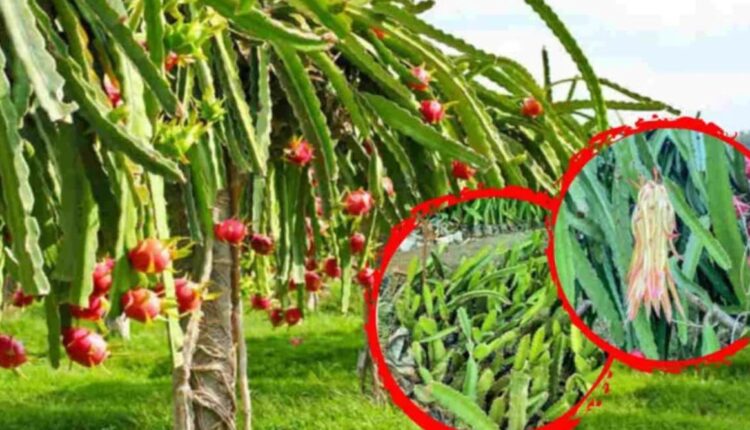This One Fruit Is Making Farmers Millionaires, And It’s Not Mango or Apple
Dragon fruit exotic fruit is becoming popular in India too.
You must have seen a big red or purple colored fruit in the market whose name many people do not know. This is the dragon fruit. Like Kiwi, this fruit has become very popular in our country. Looking at the health benefits of this, now its demand is increasing, especially in the cities.
Along with controlling obesity, diabetes, and cholesterol, dragon fruit is also beneficial in arthritis. The peel of this fruit is slightly thick, and the color of the pulp is white or purple. The taste could be sweeter but rich in vitamins and minerals. This fruit with small black-colored seeds is meager in calories and fat.
Dragon fruit (Pitaya) exotic fruit is eaten in large numbers in Mexico, Central America, and South America. This fruit is also trendy in Thailand, Vietnam, Israel, and Sri Lanka. Now Indians have also liked its taste, due to which it is being cultivated well here too.
Soil and Climate
Well-drained sandy loam soil is considered best for its cultivation. Soil pH The pH value should be between 5.5 to 7. Dragon fruit does not require much water. In this case, 40-70 cm. It can be grown well in rainfed areas. A temperature of 25-30 degrees is suitable for sound production. Like strawberries, dragon fruit also tends to spoil quickly, so special attention needs to be paid to its storage, processing, and transportation.
How is Transplanting done?
Dragon fruit can be cultivated in both seed and plant form. By the way, it is better to cultivate saplings because, with this method of planting, fruits begin to grow only after two years, while the fruits come late when seeds are planted. Plants are capable of bearing fruits only after about 4-5 years. 20 cm for planting plants from the pen. Use cuttings. The cuttings are planted in the pit. For transplanting, dig a pit of size 50X50X50 cm. Keep a distance of 2X2 meters between the pits. Leave these pits open for 15 days so that the germs are destroyed. After this, add 10-15 kg of cow dung manure and 100 grams of single phosphate per plant. After this transplant, the plants are in the pits. About 2500 plants can be planted in one hectare. Planting is done in June-July or February-March.
Manure and Fertilizers
In the first two years after transplanting, 300 grams of urea, 200 grams of phosphorus and potash should be given per plant. When the plants grow up, 540 grams of Nitrogen, 720 grams of Phosphorous and 300 grams of Potash should be given per plant every year. It does not require much water in its cultivation. Even in the winter season, its plant needs irrigation only twice a month, whereas in summer, irrigation should be done in 8-12 days.
Fruit Development
Its plants look a bit like a cactus. Since they are vine-like, the plants need support for good fruit development. Plants can be supported by making wooden or concrete poles. When fruits start coming, it should be covered with cloth or polybag. This would not only protect the fruits from high temperature, but would also keep them safe from birds and insects. Along with covering, their natural color will also develop completely.
How much is the Yield and Earning?
The weight of one fruit of dragon fruit ranges from 250 to 450 grams. In the third year of transplanting, 12-15 tonnes of fruits are obtained from one hectare. Fruits are obtained 5-6 times from August to September. Its one fruit is sold in the market for 90 to 100 rupees. Generally, trees start bearing fruits from the second or third year itself. In such a situation, on an average, Rs 3-4 lakh per hectare is earned in the second year and Rs 6-7 lakh from the fourth year. Its fruits start spoiling quickly, so proper arrangement of storage is necessary. It can be kept for 25-30 days at 8 degree centigrade temperature.
Value Addition
Apart from eating dragon fruit as a fruit, additional income can be earned by making jam, ice cream, jelly, juice and wine etc. from it. It is also used in some beauty products.
Also Read: Millets Farming: MEmillets is promoting the cultivation of coarse grains through seeds and market
Contact us – If farmers want to share any valuable information or experiences related to farming, they can connect with us via phone or whatsapp at 9599273766 or you can write to us at “[email protected]”. Through Kisan of India, we will convey your message to the people, because we believe that if the farmers are advanced then the country is happy.
You can connect with Kisan of India on Facebook, Twitter, and Whatsapp and Subscribe to our YouTube channel.



